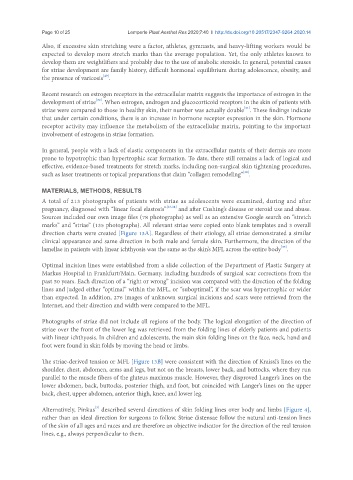Page 441 - Read Online
P. 441
Page 10 of 25 Lemperle Plast Aesthet Res 2020;7:40 I http://dx.doi.org/10.20517/2347-9264.2020.14
Also, if excessive skin stretching were a factor, athletes, gymnasts, and heavy-lifting workers would be
expected to develop more stretch marks than the average population. Yet, the only athletes known to
develop them are weightlifters and probably due to the use of anabolic steroids. In general, potential causes
for striae development are family history, difficult hormonal equilibrium during adolescence, obesity, and
[29]
the presence of varicosis .
Recent research on estrogen receptors in the extracellular matrix suggests the importance of estrogen in the
[30]
development of striae . When estrogen, androgen and glucocorticoid receptors in the skin of patients with
[31]
striae were compared to those in healthy skin, their number was actually double . These findings indicate
that under certain conditions, there is an increase in hormone receptor expression in the skin. Hormone
receptor activity may influence the metabolism of the extracellular matrix, pointing to the important
involvement of estrogens in striae formation.
In general, people with a lack of elastic components in the extracellular matrix of their dermis are more
prone to hypotrophic than hypertrophic scar formation. To date, there still remains a lack of logical and
effective, evidence-based treatments for stretch marks, including non-surgical skin tightening procedures,
[32]
such as laser treatments or topical preparations that claim “collagen remodeling” .
MATERIALS, METHODS, RESULTS
A total of 213 photographs of patients with striae as adolescents were examined, during and after
pregnancy, diagnosed with “linear focal elastosis” [33,34] and after Cushing’s disease or steroid use and abuse.
Sources included our own image files (78 photographs) as well as an extensive Google search on “stretch
marks” and “striae” (135 photographs). All relevant striae were copied onto blank templates and 3 overall
direction charts were created [Figure 13A]. Regardless of their etiology, all striae demonstrated a similar
clinical appearance and same direction in both male and female skin. Furthermore, the direction of the
[35]
lamellae in patients with linear ichthyosis was the same as the skin’s MFL across the entire body .
Optimal incision lines were established from a slide collection of the Department of Plastic Surgery at
Markus Hospital in Frankfurt/Main, Germany, including hundreds of surgical scar corrections from the
past 50 years. Each direction of a “right or wrong” incision was compared with the direction of the folding
lines and judged either “optimal” within the MFL, or “suboptimal”, if the scar was hypertrophic or wider
than expected. In addition, 276 images of unknown surgical incisions and scars were retrieved from the
Internet, and their direction and width were compared to the MFL.
Photographs of striae did not include all regions of the body. The logical elongation of the direction of
striae over the front of the lower leg was retrieved from the folding lines of elderly patients and patients
with linear ichthyosis. In children and adolescents, the main skin folding lines on the face, neck, hand and
foot were found in skin folds by moving the head or limbs.
The striae-derived tension or MFL [Figure 13B] were consistent with the direction of Kraissl’s lines on the
shoulder, chest, abdomen, arms and legs, but not on the breasts, lower back, and buttocks, where they run
parallel to the muscle fibers of the gluteus maximus muscle. However, they disproved Langer’s lines on the
lower abdomen, back, buttocks, posterior thigh, and foot, but coincided with Langer’s lines on the upper
back, chest, upper abdomen, anterior thigh, knee, and lower leg.
[3]
Alternatively, Pinkus described several directions of skin folding lines over body and limbs [Figure 4],
rather than an ideal direction for surgeons to follow. Striae distensae follow the natural anti-tension lines
of the skin of all ages and races and are therefore an objective indicator for the direction of the real tension
lines, e.g., always perpendicular to them.

